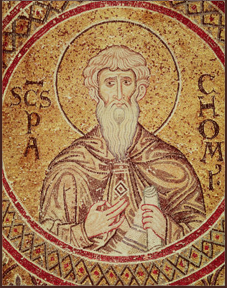Folklores from all over the world include tales of dog-headed humanoids. The phenomenon is referred to as cynocephaly, from the Greek words for "dog" and "head."
The Greeks may have been influenced by Egyptian gods with canine heads, and not just the jackal-headed Anubis; Wepwawet (originally a war deity) had a wolf head, and Duamutef (a son of Horus) had a jackal's head. The Greek physician Ctesias wrote two books in the 5th century BCE, Indica and Persica, about Persian and Indian lands, of a tribe of Cynocephali:
They speak no language, but bark like dogs, and in this manner make themselves understood by each other. Their teeth are larger than those of dogs, their nails like those of these animals, but longer and rounder. They inhabit the mountains as far as the river Indus. Their complexion is swarthy. They are extremely just, like the rest of the Indians with whom they associate. They understand the Indian language but are unable to converse, only barking or making signs with their hands and fingers by way of reply... They live on raw meat. They number about 120,000.
Other Ancient Greek writers including Herodotus, likely influenced by Ctesias, reinforced this knowledge, encouraging the Middle Ages to accept that there were strange races living beyond Europe. (Greek writers also say there was a type of monkey that was cynocephalic; we now assume they had seen baboons.)
With this "knowledge" in hand, it was easy to accept that Cynocephali would appear in other accounts, such as that of two dog-headed saints, Ahrakas and Augani, who served the
Coptic Saint Mercurius (3rd century).
The best-known dog-headed personage was St. Christopher, who was sometimes depicted in the Eastern Orthodox tradition as dog-headed. This was likely a misunderstanding of an expanded history for him that referred to him as a Canaanite; this was mis-read as "canine-ish" and resulted in him being portrayed as a Cynocephalus who came from their tribe.
St. Augustine of Hippo in his The City of God addressed the topic of the Cynocephali. He accepted that they might not exist, but if they did exist, were the human (which to him meant mortal and rational). If they were both mortal and rational, then they were human, and therefore could have come from nowhere but a line of descendants from Adam.
Ratramnus (died c.868), a Frankish theologian, was concerned about the Cynocephali, because if they were human, then it was obligatory to bring Christianity to them.
Even Marco Polo mentions them:
Angamanain is a very large Island. The people are without a king and are Idolaters, and no better than wild beasts. And I assure you all the men of this Island of Angamanain have heads like dogs, and teeth and eyes likewise; in fact, in the face they are all just like big mastiff dogs! They have a quantity of spices; but they are a most cruel generation, and eat everybody that they can catch, if not of their own race.
The one medieval writer who personally encountered anything approaching Cynocephali was Ibn Battuta (who was mentioned in passing a week ago regarding the Richest Man of All Time):
Fifteen days after leaving Sunaridwan we reached the country of the Barahnakar, whose mouths are like those of dogs. This tribe is a rabble, professing neither the religion of the Hindus nor any other. They live in reed huts roofed with grasses on the seashore, and have abundant banana, areca, and betel trees. Their men are shaped like ourselves, except that their mouths are shaped like those of dogs; this is not the case with their womenfolk, however, who are endowed with surpassing beauty.
Between India and Sumatra is a tribe, the Mentawai, who practice the art of tooth sharpening. He may have encountered them.
Dog-headed humanoids were widespread in literature, mentioned in the Nowell Codex (that contains Beowulf); in a Welsh poem where King Arthur fights them in Edinburgh; lamented at by Charlemagne (in his biography) that he never had a chance to go to war against such a foe; in a Flemish Dominican's popular encyclopedic work corroborating their existence; and many more examples. After the European discovery of the continents west of the Atlantic Ocean, assumptions that the Cynocephali would be found were renewed.
But enough of that. Lots of options to move on from here, but I want to explore that Flemish Dominican who wrote some works that became very popular, based on the number of surviving manuscripts. Next time we will talk about Thomas of Cantimpré.










